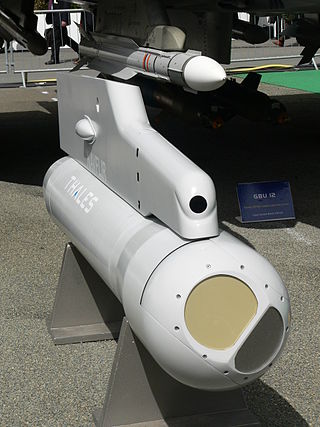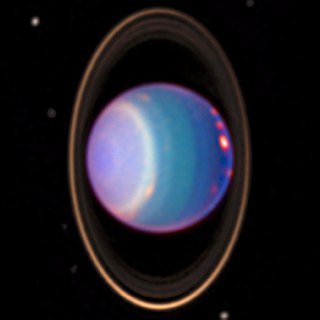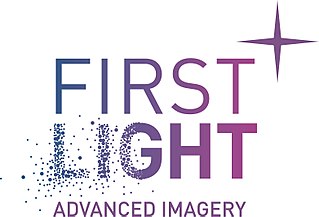
Forward-looking infrared (FLIR) cameras, typically used on military and civilian aircraft, use a thermographic camera that senses infrared radiation.

A thermographic camera is a device that creates an image using infrared (IR) radiation, similar to a normal camera that forms an image using visible light. Instead of the 400–700 nanometre (nm) range of the visible light camera, infrared cameras are sensitive to wavelengths from about 1,000 nm to about 14,000 nm (14 μm). The practice of capturing and analyzing the data they provide is called thermography.

The Near Infrared Camera and Multi-Object Spectrometer (NICMOS) is a scientific instrument for infrared astronomy, installed on the Hubble Space Telescope (HST), operating from 1997 to 1999, and from 2002 to 2008. Images produced by NICMOS contain data from the near-infrared part of the light spectrum.

A microbolometer is a specific type of bolometer used as a detector in a thermal camera. Infrared radiation with wavelengths between 7.5–14 μm strikes the detector material, heating it, and thus changing its electrical resistance. This resistance change is measured and processed into temperatures which can be used to create an image. Unlike other types of infrared detecting equipment, microbolometers do not require cooling.
A staring array, also known as staring-plane array or focal-plane array (FPA), is an image sensor consisting of an array of light-sensing pixels at the focal plane of a lens. FPAs are used most commonly for imaging purposes, but can also be used for non-imaging purposes such as spectrometry, LIDAR, and wave-front sensing.
Lead selenide (PbSe), or lead(II) selenide, a selenide of lead, is a semiconductor material. It forms cubic crystals of the NaCl structure; it has a direct bandgap of 0.27 eV at room temperature. A grey solid, it is used for manufacture of infrared detectors for thermal imaging. The mineral clausthalite is a naturally occurring lead selenide.
Thales Nederland B.V. is a subsidiary of the French multinational company Thales Group based in the Netherlands.
Soitec is an international company based in France, that manufactures substrates used in the creation of semiconductors.
Bharat Electronics Limited (BEL) is an Indian Government-owned aerospace and defence electronics company. It primarily manufactures advanced electronic products for ground and aerospace applications. BEL is one of sixteen PSUs under the Ministry of Defence of India. It has been granted Navratna status by the Government of India.

SRON Netherlands Institute for Space Research (SRON) is a national Dutch institute for space research. It develops and uses innovative technology for analysis in space, focusing on astrophysical research, Earth observation, and exoplanetary research. SRON research includes new and more advanced sensors for X-rays, infrared radiation, and visible light.
Ophir Optronics Solutions is a multinational company that sells optronics solutions. The company develops, manufactures and markets infrared (IR) optics and laser measurement equipment. Founded in 1976, the company was traded on the Tel Aviv Stock Exchange from 1991 until it was acquired, and was a constituent of its Tel-tech index. Headquartered in the Har Hotzvim industrial park in Jerusalem, Israel Ophir owns a 100,000-square-foot (9,300 m2) complex that includes the group's main production plant. Ophir has additional production plants in North Andover, Massachusetts and Logan, Utah in the US and sales offices in the US, Japan and Europe. In 2006, Ophir acquired Spiricon Group, a US-based company in the beam-profiling market. Ophir's sales increased sharply from $45 million in 2005 to $74 million in 2007. During 2007, Ophir established a Swiss-based subsidiary to market lenses and components for surveillance and imaging systems in Europe. In May 2010, Ophir acquired Photon Inc., another US-based beam-profiling company. Newport Corporation, a global supplier in photonics solutions, completed its acquisition of the Ophir company in October 2011. In 2016, metrology firm MKS Instruments bought Newport Corporation, including the Ophir brand, for $980 million.
Infrared vision is the capability of biological or artificial systems to detect infrared radiation. The terms thermal vision and thermal imaging are also commonly used in this context since infrared emissions from a body are directly related to their temperature: hotter objects emit more energy in the infrared spectrum than colder ones.

CEA-Leti is a research institute for electronics and information technologies, based in Grenoble, France. It is one of the world's largest organizations for applied research in microelectronics and nanotechnology. It is located within the CEA Grenoble center of the French Alternative Energies and Atomic Energy Commission (CEA).

SAFIR is a proposed NASA space observatory for far-infrared light. The plan calls for a single large mirror 5–10 meters (16–33 ft) in diameter, cryogenically cooled to 5 kelvins. This would feed detector arrays sensitive from 5 to 1000 μm. The possibility of servicing such a telescope in space has been evaluated.

The NIRSpec is one of the four scientific instruments flown on the James Webb Space Telescope (JWST). The JWST is the follow-on mission to the Hubble Space Telescope (HST) and is developed to receive more information about the origins of the universe by observing infrared light from the first stars and galaxies. In comparison to HST, its instruments will allow looking further back in time and will study the so-called Dark Ages during which the universe was opaque, about 150 to 800 million years after the Big Bang.

A Readout integrated circuit (ROIC) is an integrated circuit (IC) specifically used for reading detectors of a particular type. They are compatible with different types of detectors such as infrared and ultraviolet. The primary purpose for ROICs is to accumulate the photocurrent from each pixel and then transfer the resultant signal onto output taps for readout. Conventional ROIC technology stores the signal charge at each pixel and then routes the signal onto output taps for readout. This requires storing large signal charge at each pixel site and maintaining signal-to-noise ratio as the signal is read out and digitized.
Composante Spatiale Optique is a French military Earth observation satellite program of third generation. It replaces the Helios 2 satellites. It is sometimes referred to as the MUltinational Space-based Imaging System for Surveillance, Reconnaissance and Observation.
Safran Electronics & Defense, formerly known as Sagem Défense Sécurité, is a French company specializing in optronics, avionics and electronic systems, as well as software for civil and military applications in the naval, aeronautical and space sectors. It is one of the ten entities that make up the Safran Group.

First Light Imaging is a French company headquartered in Meyreuil near to Aix-en-Provence, France. The company designs and manufactures scientific cameras for visible and infrared spectra based on EMCCD, e-APD. and InGaAs technologies.
Weebit Nano is a public semiconductor IP company founded in Israel in 2015 and headquartered in Hod Hasharon, Israel. The company develops Resistive Random-Access Memory technologies. Resistive Random-Access Memory is a specialized form of non-volatile memory (NVM) for the semiconductor industry. The company’s products are targeted at a broad range of NVM markets where persistence, performance, and endurance are all required. ReRAM technology can be integrated in electronic devices like wearables, Internet of Things (IoT) endpoints, smartphones, robotics, autonomous vehicles, and 5G cellular communications, among other products. Weebit Nano’s IP can be licensed to semiconductor companies and semiconductor fabs.









